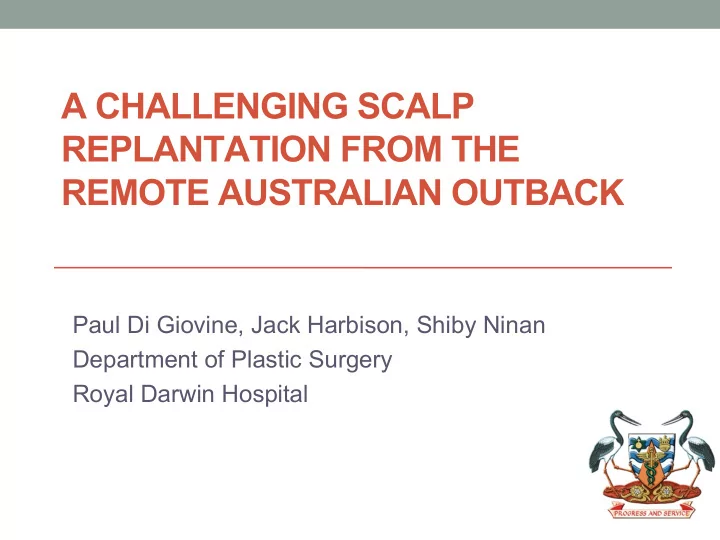

A CHALLENGING SCALP REPLANTATION FROM THE REMOTE AUSTRALIAN OUTBACK Paul Di Giovine, Jack Harbison, Shiby Ninan Department of Plastic Surgery Royal Darwin Hospital
Introduction • Scalp avulsion is a rare disfiguring injury caused by shearing forces acting obliquely at the interface between periosteum and galea • Before the advent of microsurgery these injuries were managed by relaying the avulsed segment as a composite graft, or skin grafting, with failure resulting in areas of scarred non-hair bearing scalp
Introduction • While it is often reported that chances of successful replantation decrease after 5-6 hours of ischemia time, there have now been reports of good outcomes with longer periods before revascularization • This is of particular relevance in Australia, where geographical isolation results in extended periods of ischemia before treatment can be delivered
Case Study • We present a 18 year old girl who sustained a crush avulsion of her left temporoparietal scalp after her hair was caught in a bore pump on cattle station • 130km from the nearest town and 430km from the nearest tertiary hospital
Case study • She was retrieved by plane to the Royal Darwin Hospital with a warm ischemia time of 5 hours, and total ischemia time of 13 hours
Case study • Despite the poor quality of the avulsed segment, it was decided to attempt replantation • The patient and avulsed scalp were prepared concurrently • Initially it was only possible to identify a single artery and this was anastomosed to the superficial temporal artery • Once the flap was perfused a single vein was identified for anastomosis via a vein graft to vein in the occipital region, as the degloving mechanism precluded the use of local scalp veins
Deep aspect of avulsed segment The prepared defect The avulsed segment
At conclusion of replantation
2 weeks postoperatively Area of distal necrosis at tip of smaller flap which was allowed to heal by secondary intention
1 month postoperatively
3 months postoperatively Good hair regrowth Hypertrophic postauricular scar receiving scar management
Conclusion • Microvascular replantation of the scalp provides the best potential for acceptable cosmetic outcome and should always be considered • Despite the unfavorable conditions of crush and avulsion at two different planes, long ischemia time and contamination, a good result was achieved
Recommend
More recommend